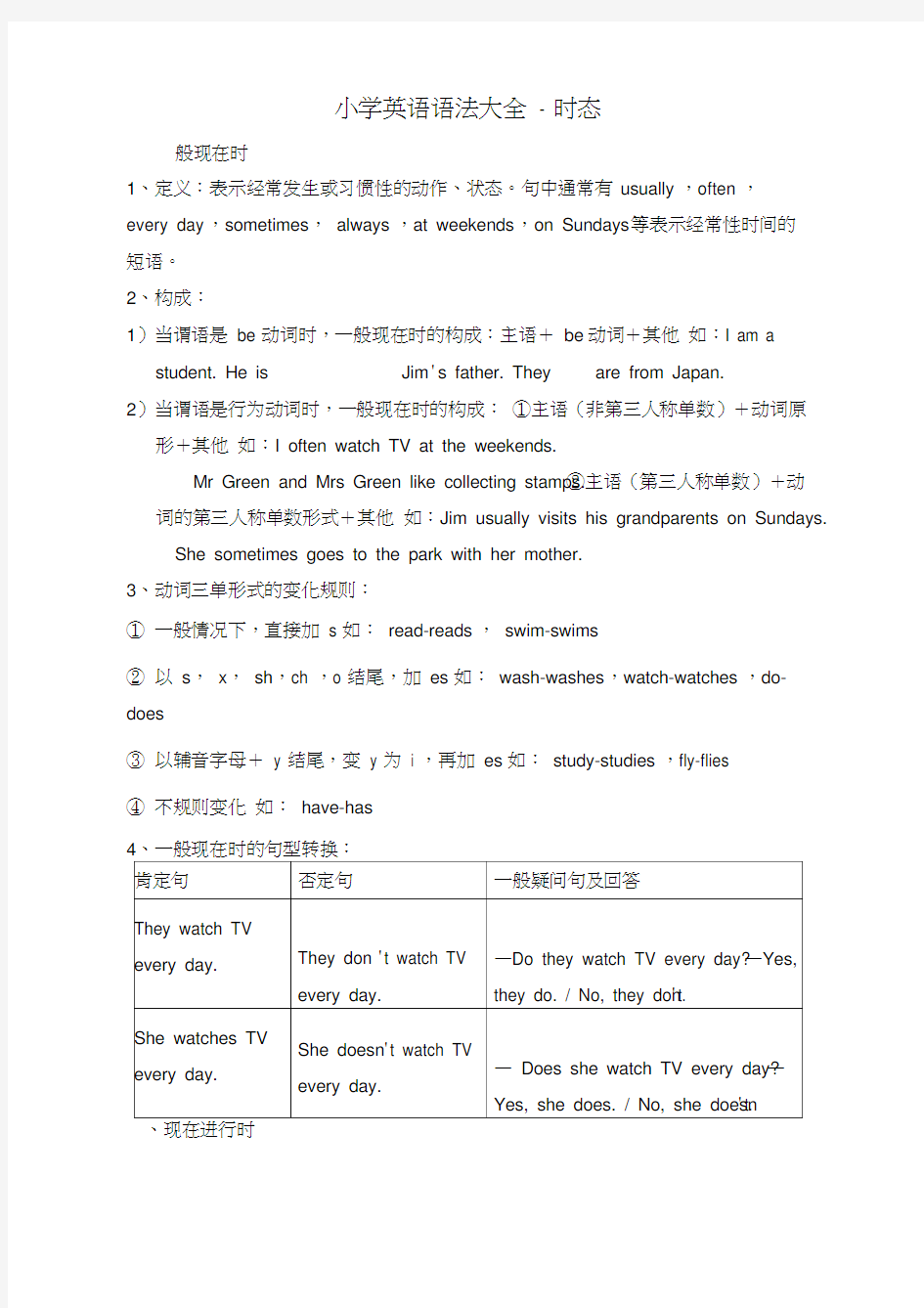

小学英语语法大全- 时态
般现在时
1、定义:表示经常发生或习惯性的动作、状态。句中通常有usually ,often ,every day ,sometimes,always ,at weekends ,on Sundays 等表示经常性时间的短语。
2、构成:
1)当谓语是be 动词时,一般现在时的构成:主语+be动词+其他如:I am a student. He is Jim's father. They are from Japan.
2)当谓语是行为动词时,一般现在时的构成:①主语(非第三人称单数)+动词原形+其他如:I often watch TV at the weekends.
Mr Green and Mrs Green like collecting stamps. ②主语(第三人称单数)+动词的第三人称单数形式+其他如:Jim usually visits his grandparents on Sundays.
She sometimes goes to the park with her mother.
3、动词三单形式的变化规则:
①一般情况下,直接加s 如:read-reads ,swim-swims
②以s,x,sh,ch ,o 结尾,加es 如:wash-washes,watch-watches ,do-does
③以辅音字母+y 结尾,变y 为i ,再加es 如:study-studies ,fly-flies
④不规则变化如:have-has
4、一般现在时的句型转换:
、现在进行时
1、定义:表示现在或现阶段正在进行或发生的动作。句中常有now,look ,listen 等词。
如:I am washing clothes now.
Look! Liu Tao is climbing the tree.
Listen! Jane is singing in the music room.
2、构成:be 动词(am/is/are )+ 动词现在分词(V-ing )
3、动词现在分词构成:
①一般是在动词原形后加ing
如:read-reading ,drink-drinking ,eat-eating ,look-looking
②以不发音的 e 结尾的动词,去掉e,再加ing
如:write-writing ,make-making,ride-riding ,take-taking
③以重读闭音节结尾,如末尾只有一个辅音字母,要双写这个字母,再加ing
如:sit-sitting ,swim-swimming,put-putting ,run-running ,stop-
stopping ,get-getting ,begin-beginning ,jog-jogging ,forget- forgetting 4、动名词其实就是动词的现在分词,它既有名词性质(可作主语),又有动词性质(可带宾语)。
如:Asking the way
My hobby is collecting stamps.
He is good at skating.
5、现在进行时的句型转换:
三、一般过去时
1、定义:表示过去某个时间里发生的动作或存在的状态。常和表示过去的时间状语连用,如: a moment ago,just now ,yesterday ,last week ,this morning
如:My brother often went to school by bike last term.
The watch was beside the diary a moment ago.
I watched the moon and ate the moon cakes last Mid-Autumn Festival. Jim went to
the supermarket yesterday.
2、构成:主语+动词的过去式+其他
3、动词过去式的变化规则:
①一般在动词原形末尾加ed
如:play-played ,listen-listened ,look-looked
②结尾是 e 的动词,加d
如:live-lived ,like-liked ,taste-tasted
③辅音字母+y 结尾的动词,变y 为i ,再加ed
如:study-studied ,carry-carried ,cry-cried
④末尾只有一个辅音字母的重读闭音节词,双写这个辅音字母,再加ed 如:
stop-stopped ,plan-planned
⑤不规则变化如:
am/is-was sit-sat give-gave eat-ate are-were tell-told read-read fly-flew have/has-had see-saw buy-bought meet-met do-did get-got come-came put-put go-went make-made draw-drew run-ran say-said
sing-sang swim-swam take-took
4、一般过去时的句型转换
第15 讲一般将来时
1、定义:表示将要发生的动作或存在的状态,以及打算、计划或准备某事。句中一般含有表示将来的时间状语,如:tomorrow morning ,next week ,this afternoon 等表示将来的时间状语。
2、构成:
①be gong to + 动词原形
如:I am going to see a Beijing opera tomorrow.
We are going to meet at bus stop at half past ten.
Dad and I are going to see a Beijing opera this afternoon.
②will + 动词原形
如:They will go swimming this afternoon.
3、be going to 和will 区别:
① be going to 表示经过事先安排、打算或决定要做的事情,基本上一定会发生;will 则表示有可能去做,但不一定发生,也常表示说话人的临时决定。
如:I am going to take part in a party this evening.
They are cleaning the library now. I ' ll go and join them.
②be going to 表示近期或眼下就要发生的事情;will 表示的将来时间则较远一
些。如:He is going to write a letter tomorrow. I will meet her one day.
③be going to 还可以用来表示有迹象表明某件事将要发生,常用于天气等自然现象。如:Look! It 's going to rain.
4、一般将来时句型转换: